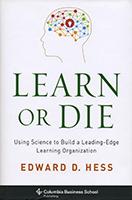Learn or Die

Description
To compete with today's increasing globalization and rapidly evolving technologies, individuals and organizations must take their ability to learn--the foundation for continuous improvement, operational excellence, and innovation--to a much higher level. In Learn or Die, Edward D. Hess combines recent advances in neuroscience, psychology, behavioral economics, and education with key research on high-performance businesses to create an actionable blueprint for becoming a leading-edge learning organization.
Learn or Die examines the process of learning from an individual and an organizational standpoint. From an individual perspective, the book discusses the cognitive, emotional, motivational, attitudinal, and behavioral factors that promote better learning. Organizationally, Learn or Die focuses on the kinds of structures, culture, leadership, employee learning behaviors, and human resource policies that are necessary to create an environment that enables critical and innovative thinking, learning conversations, and collaboration. The volume also provides strategies to mitigate the reality that humans can be reflexive, lazy thinkers who seek confirmation of what they believe to be true and affirmation of their self-image. Exemplar learning organizations discussed include the secretive Bridgewater Associates, LP; Intuit, Inc.; United Parcel Service (UPS); W. L. Gore & Associates; and IDEO.
Specs
Book highlights four key points to keep in mind when building a learning culture:
- Leadership must shift toward "coaching-ship." Instead of "knowing and telling," which can cause progress-limiting dependence, leaders should work with employees as coaches, or even allow them to experiment on their own.
- Your work environment must be an emotionally positive one. Positive emotional work environments are no longer negotiable; they're a requirement. Positive emotions are associated with openness to new ideas, better problem solving, openness to disconfirming information, less rigid thinking, resilience, creativity, collaboration, better recall of neutral or positive stimuli, and mitigation of ego defenses.
- High employee emotional engagement is a necessity. It stands to reason that if employees don't have an emotional investment in your company and their futures in it, they won't be motivated to learn. It comes down to meeting employee's needs for autonomy, effectiveness, and relatedness. And these needs are most likely to be met when individuals feel respected, trusted, and cared for, and feel that they can trust the organization and its leaders.
- Employees need permission to TRY and FAIL. Learning is not an efficient 99% defect-free process, so mistakes have to be valued as learning opportunities. Employees must be given conditional permission to fail within proscribed financial tolerances, with the knowledge that they won't be punished for their mistakes so long as they learn.
